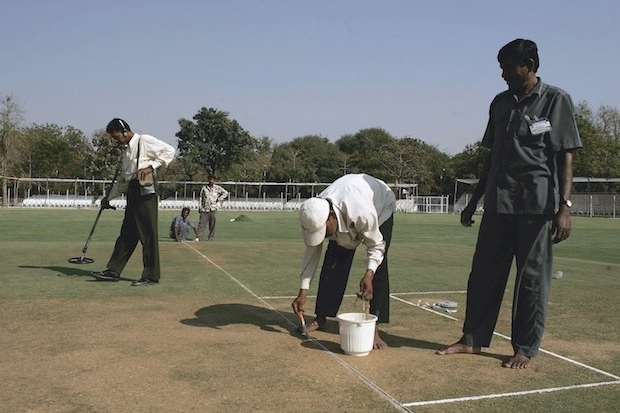It isn’t just the elk, either. Also bringing proceedings to a halt in this wonderful anthology are camels (Bahrain), cows and donkeys (Botswana), unexploded landmines (Rwanda, silly mid-on), people learning to drive (East Timor), punch-ups (Bermuda), low cloud (Christmas Island, 300 metres above sea-level), mortars (Iraq, though not during the game held by coalition forces in the ballroom-sized anteroom of Saddam’s abandoned North Palace) and weddings (the ground on Ascension Island has a church inside its boundary). For the record, the elk (Finland) was twice the size of a horse.
Even when play is possible, life can still be tricky. In the Cook Islands, the locals’ decision ‘to use a flip-flop to screed the concrete rather than a trowel meant conditions looked like being a challenge for the batsmen’. Players in Brunei arrive to find that soccer goals have been sited at short midwicket, while in the Falkland Islands ‘those bowling into the wind regularly struggle to reach the opposite end’. The sheer variety of cricket across the planet is astonishing. One Sri Lankan bowler kisses the ball before every delivery, a stockbrokers’ XI touring Chile take the field with a gin and tonic in each hand, while in Kosovo a team of Gurkhas includes Rifleman Chandrakumar Limbu-by-Prasad Chamarty, ‘whose name troubled the scorers almost as much as his runs did’.
Wisden’s ‘Cricket Round the World’ section only started in 1993, though as its correspondents are such a learned bunch, historical references inevitably creep in. In 1886, for instance, a fielder on St Helena died chasing the ball over a cliff. The Russian Tsar Nicholas I, on witnessing a cricket match at Chatham, remarked: ‘I don’t wonder at the courage of you English, when you teach your children to play with cannon-balls.’ The MCC’s first overseas tour was scheduled for France — unfortunately they chose the year 1789, crossed the Channel to find the revolution in full swing, and promptly came home. More recent history includes Ted Dexter travelling to and from boarding school on the Orient Express. This is because he was brought up in Milan, though knowing Dexter you suspect the same would have happened even if he’d been brought up in Surrey.
This could be just another book destined for the loo of someone you know who likes cricket and has an approaching birthday. But it isn’t. Love shines from its pages, a love for cricket evident in both the reports themselves and the way the editor, Charlie Connelly, has updated them. Love, too, for people as well as the game. Cricket is being used to bring together Palestinian and Jewish children: ‘When holding a cricket bat,’ says one of the former, ‘I feel I hold the whole world.’ In Peru, Indians and Pakistanis play on the same team. And in south-central Los Angeles the LA Kricketts have enjoyed great success rescuing teenagers from a life lost to gang culture. ‘If the British did anything right,’ remarks Ted Hayes, the community worker responsible, ‘they did right when they invented cricket.’






Comments